There is a notable increase in nearshore outsourcing among U.S. manufacturing executives, rising from 78% last year to 92% in 2024. As businesses struggle with finding the right talent, nearshore outsourcing offers a compelling solution by bridging geographical and skill gaps without the complexities of managing distant offshore teams. But how exactly does this model work, and what benefits does it offer your business?
In this blog, you will explore:
- The definition and key characteristics of nearshore outsourcing.
- Strategic benefits of nearshore outsourcing.
- Nearshore outsourcing meaning.
- How nearshore outsourcing can drive business growth and competitiveness.
- Real-life success stories and case studies demonstrating its impact.
P.S., Looking to elevate your business operations with expert nearshore outsourcing? Partner with Miquido to seamlessly integrate top IT talent into your strategy. From team augmentation services and custom app development to advanced mobile app solutions, we empower leaders to exceed industry standards and enhance customer satisfaction. Transform your vision into reality; connect with us today!
What is Nearshore Outsourcing?
Nearshore outsourcing is a business practice where companies outsource services or operations to a nearby country that is typically within a similar time zone. The geographical proximity facilitates better communication, reduces language barriers, and allows for closer cultural alignment compared to offshore outsourcing, where services are often outsourced to distant countries.
Nearshore Outsourcing Meaning
With these advantages, nearshore outsourcing has gained significant traction as businesses seek efficient ways to optimize operations and resources. Europe is a leading hub for nearshore outsourcing, with Poland distinguishing itself as a top destination in Europe.
Nearshore vs. Offshore Outsourcing: A Comparative Overview
| Aspect | Nearshore Development | Offshore Development |
| Location | A team in a geographically close country. | A team in a distant country. |
| Proximity | Close proximity facilitates easier access to the team. | Greater geographical distance may cause delays. |
| Cultural Alignment | More likely to share similar cultural norms and business practices. | Potential cultural differences can impact collaboration. |
| Communication | Better aligned time zones allow more real-time communication. | Heavily relies on digital communication tools due to different time zones. |
| Talent Pool | Access to a broader talent pool than onshore but may be limited compared to offshore. | Access to a global talent pool, offering a wide range of skills. |
| Language Barrier | Reduced language barriers due to regional similarities. | Possible language challenges, requiring clear communication strategies. |
| Time Zone Impact | Minor time zone differences ease meeting scheduling and collaboration. | Significant time zone differences require careful scheduling. |
| Work Cycle | Work hours more closely aligned with local times, easing collaboration. | Possible 24-hour work cycle, benefiting project turnarounds. |
Both nearshore or offshore outsourcing have distinct advantages and challenges that can significantly impact operational efficiency and business outcomes.
- Geographic proximity:
- Nearshore: Involves outsourcing services to a geographically close country, often sharing a border or being in the same or a nearby time zone.
- Offshore: Outsourcing services to geographically distant countries, often involving different continents and significant time zone differences.
- Cultural Affinity:
- Nearshore: Typically, nearshore partners share cultural similarities, which can facilitate smoother communication and fewer cultural barriers.
- Offshore: Cultural differences are more pronounced, leading to communication challenges and misunderstandings.
- Communication:
- Nearshore: Communication is easier due to similar time zones and cultural familiarity. Meetings and real-time collaboration are more feasible.
- Offshore: Potential delays in communication due to time zone differences, which might hinder real-time interactions and can affect project timelines.
- Cost:
- Nearshore: Nearshore outsourcing is often seen as an economic option. It balances cost-effectiveness with the benefits of geographical proximity and similar time zones. Businesses that opt for nearshoring can achieve up to 40% annual savings on employee costs by partnering with companies in Eastern Europe.
- Offshore: Typically less expensive, appealing for cost reduction strategies due to lower labor costs in offshore locations.
- Economic and Political Stability:
- Nearshore: Countries are often economically and politically more stable than the home country, reducing operational risks.
- Offshore: Political and economic instability can be a concern, depending on the offshore country, potentially impacting the reliability of outsourcing arrangements.
- Response Time and Agility:
- Nearshore: Faster response times and greater agility in addressing issues due to proximity and fewer time zone differences.
- Offshore: Response times can be slower, and the need for extensive coordination can decrease operational agility.
- Talent Pool and Expertise:
- Nearshore: Access to a similar talent pool with similar educational backgrounds and expertise.
- Offshore: Access to a diverse and often larger talent pool, which can include highly specialized skills at a lower cost.
- Regulatory Compliance and Data Security:
- Nearshore: Often easier compliance with regulations due to similar legal frameworks and standards.
- Offshore: Compliance can be more challenging due to differing regulations and standards, requiring more due diligence.
Nearshore Outsourcing Meaning & Benefits
This model offers several benefits over both offshore outsourcing and onshore outsourcing. Let’s explore the advantages of nearshore outsourcing:
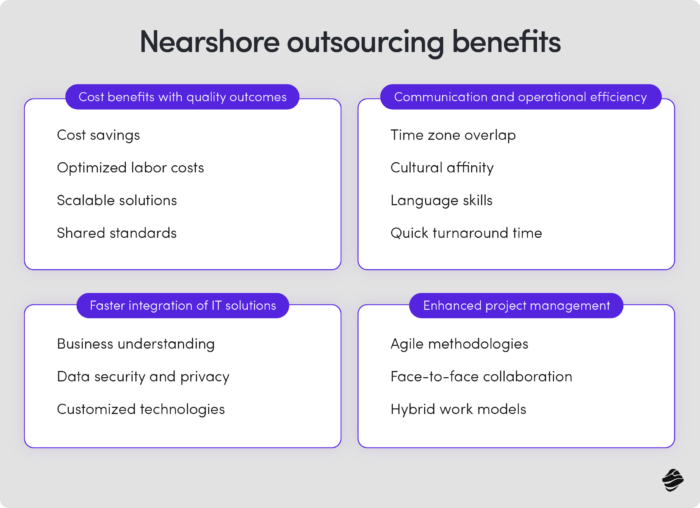
1. Cost benefits with quality outcomes
Nearshore outsourcing allows companies to achieve substantial cost reductions. Research indicates that cost savings remain a primary driver, with 59% of companies outsourcing to reduce expenses.
- Optimized labor costs: It provides significant savings by accessing talent in neighboring regions where labor costs are relatively lower than in Western Europe. Despite reduced labor costs, these regions often have robust educational systems producing high-caliber IT professionals.
- Scalable solutions: The geographical closeness allows nearshore partners to scale operations up or down more quickly, ensuring that businesses only pay for what they need. This flexibility is crucial for non-tech industries needing IT support during busy seasons or for specific projects.
- Shared standards: Nearshore outsourcing simplifies compliance because nearby countries often share similar legal frameworks. For instance, within the EU, member states follow EU laws, making it easier to navigate regulatory requirements.
2. Communication and operational efficiency
Nearshore outsourcing significantly enhances communication and operational efficiency by reducing cultural and language barriers, aligning time zones, and facilitating closer collaboration.
Some key ways by which nearshore outsourcing enhances communication and operational efficiency are:
- Time zone overlap: Sharing similar time zones enables teams to collaborate more effectively. This overlap eliminates long response times in offshore outsourcing, where communication can be delayed by several hours.
- Cultural affinity: Cultural proximity facilitates smoother communication, reduces misunderstandings, and improves team rapport. This rapport is vital for gathering precise requirements and aligning projects.
- Language skills: Many European nearshore partners emphasize multilingual education, making them proficient in multiple languages, including English and German. This proficiency simplifies cross-border communication.
- Quick turnaround time: Nearshore outsourcing provides quicker turnaround times due to time zone overlaps and streamlined communication. This immediacy helps accelerate issue resolution and project completion, minimizing downtime.
3. Faster integration of IT solutions
It is a powerful strategy for businesses seeking to enhance efficiency and innovate within their IT infrastructure. This method proves particularly effective in optimizing IT solutions through a combination of deep market understanding, stringent data security measures, and customized technology solutions.
Here’s a detailed look at the specific benefits:
- Business understanding: Nearshore partners often have a better grasp of the European market environment and business practices, enabling them to deliver tailored IT solutions that address industry-specific challenges.
- Data security and privacy: Shared GDPR and data privacy frameworks mean that nearshore partners adhere to the same data protection guidelines, offering confidence in managing sensitive business information.
- Customized technologies: Nearshore teams can modify existing software tools or design new systems that seamlessly fit into various business models, reducing downtime and disruption during adoption.
4. Enhanced project management
Nearshore outsourcing meaning lies in enhancing project management capabilities, particularly within fast-paced IT and software development industries. Streamlined collaboration and communication enable teams to respond swiftly and adapt effectively to changing project demands.
It can enhance project management in the following ways:
- Agile methodologies: Nearshore outsourcing encourages agile project management practices, with frequent communication enabling iterative development and adaptive planning, which are crucial for IT projects.
- Face-to-face collaboration: Geographical closeness enables regular on-site visits for project kick-offs, critical milestones, or strategic planning sessions, enhancing teamwork and partnership spirit.
- Hybrid work models: Many nearshore teams are well-versed in hybrid or remote work models, which allow them to integrate seamlessly with the business’s internal workforce and optimize productivity.
8 Essential Key Considerations for Selecting a Nearshore Partner
Selecting the right nearshore partner is crucial for the success of your outsourcing strategy. Here are essential factors to ensure alignment with your business objectives and operational needs.
- Industry-specific expertise: Choose partners with proven experience and knowledge in your industry to ensure they understand your business needs and regulatory requirements.
- Technological capabilities: Assess the nearshore outsourcing company technological infrastructure and capabilities, including their use of modern tools and technologies relevant to your projects.
- Track record and reliability: Evaluate the partner’s history of success through case studies, client testimonials, and performance metrics to gauge their reliability and effectiveness.
- Cultural compatibility: Ensure the partner aligns with your company’s culture and values, facilitating smoother interactions and a more productive working relationship.
- Communication proficiency: Confirm that the team has strong communication skills, particularly in your preferred language, to avoid misunderstandings and ensure clear, consistent interactions.
- Flexibility and scalability: Check for flexibility in service agreements and the ability to scale operations up or down based on your business needs, which can provide significant strategic benefits.
- Data security and compliance: Verify that the partner adheres to stringent data security protocols and compliance standards relevant to your industry to protect sensitive information and avoid legal issues.
- Cost structure: Analyze the cost-effectiveness of their services, not just in terms of initial expenses but also considering long-term value addition and potential cost savings.
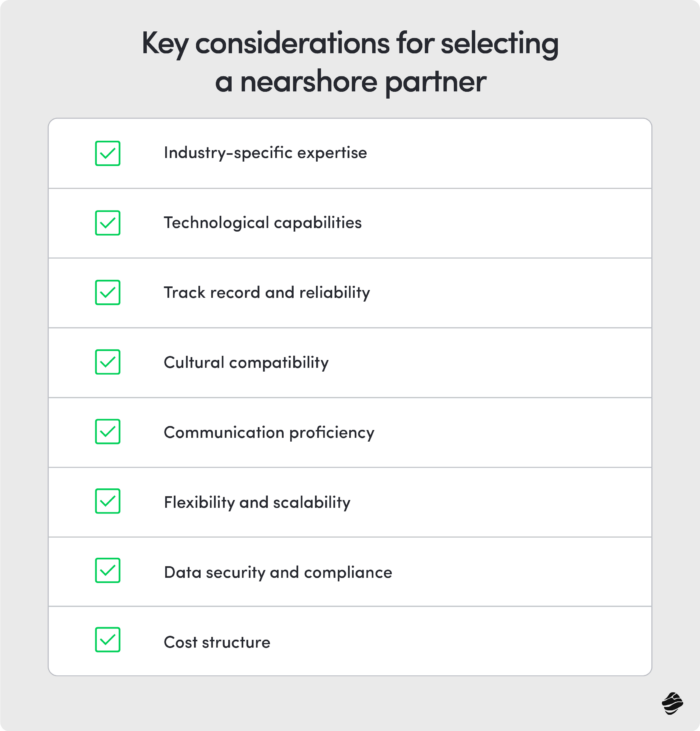
Future Trends in Nearshore Outsourcing and Their Impact on Global Business
Nearshore outsourcing services will transform in response to dynamic global trends and emerging business needs. Below, we will explore how these shifts are expected to impact global business strategies and offer new opportunities for growth and collaboration.
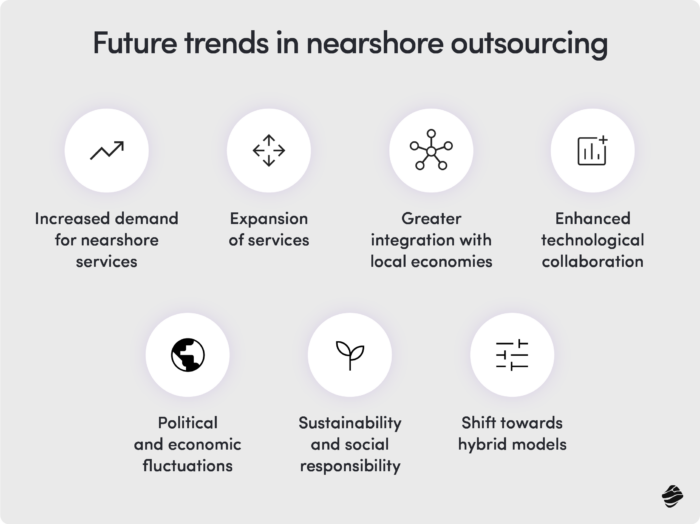
- Increased demand for nearshore services: As companies seek to balance cost with quality, nearshore outsourcing is expected to grow, driven by its communication and cultural compatibility advantages.
- Expansion of services: Nearshore providers will likely expand their offerings to include specialized and high-value services, such as artificial intelligence, cybersecurity, and advanced data analytics.
- Greater integration with local economies: Nearshore outsourcing will increase local economic growth, prompting countries to improve infrastructure and education to attract more foreign businesses.
- Enhanced technological collaboration: The rise of digital communication tools and platforms will make collaboration across borders smoother and more efficient, bolstering the appeal of nearshore solutions.
- Political and economic fluctuations: Changes in trade policies and international relations could influence nearshore outsourcing trends, with businesses needing to stay agile to adapt to new regulations and economic conditions.
- Sustainability and social responsibility: Companies will likely consider environmental impact and corporate social responsibility in their outsourcing decisions, favoring nearshore options that align with these values.
- Shift towards hybrid models: Businesses may adopt a hybrid approach, combining nearshore and offshore outsourcing to optimize costs and benefits, tailoring strategies to specific project needs and market conditions.
Real-World Examples of Nearshore Outsourcing
Businesses are now increasingly turning to nearshore outsourcing partners to efficiently manage healthcare, retail, and manufacturing projects. By leveraging teams’ expertise in nearshore locations, organizations are effectively achieving their business goals and adapting to the evolving market demands.
Below are some case studies that showcase the successful application of nearshore software development outsourcing in various industries:
1. HelloFresh

HelloFresh is a premier meal delivery service that specializes in providing fresh, dietician-approved meals directly to customers. To enhance its digital user experience, HelloFresh needed a more intuitive and personalized app to streamline the meal selection and ordering process.
To achieve this, it chose nearshore outsourcing and partnered with Miquido. This collaboration focused on refining the app’s functionality and interface to improve customer satisfaction and streamline ordering.
Miquido approach
- Developed a streamlined app interface for easy meal plan navigation.
- Integrated flexible meal plan options for diverse dietary needs.
- Implemented a seamless ordering process for quick meal selection and delivery.
Results
- Achieved a simpler, clearer app interface improving user experience.
- Reduced time required for meal selection and ordering.
- Successfully transitioned grocery shopping to a digital environment.
2. Skyscanner
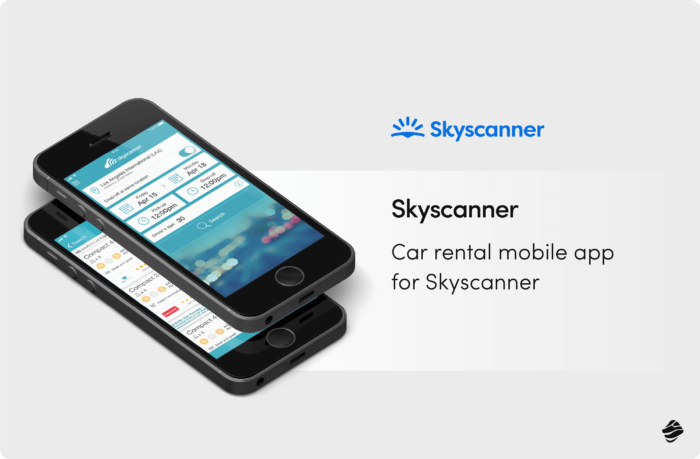
Skyscanner is a popular travel app with a user base of over 100 million worldwide. The app offers various travel booking services, including flights, hotels, and car rentals, making it a one-stop solution for travelers. However, Skyscanner faced challenges with its car rental module, such as low conversion rates, an immature mobile channel, difficult maintenance, and scaling issues.
To address these challenges, Skyscanner partnered with Miquido, a leading mobile app development company. Miquido aimed to make the app more user-friendly, visually appealing, and competitive.
Miquido approach
- Updated the Skyscanner app with new mobile technologies like Java for Android and Objective-C for iOS.
- Integrated mapping technologies using Google Maps API for Android and MapKit framework for iOS.
- Improved search functionality for rental offers based on the user’s location.
- Introduced features for comparing and filtering rental cars based on criteria like fuel policy and provider rating.
- Implemented a last-minute feature for renting vehicles at discounted prices.
Results
- Skyscanner’s Car Rental app experienced a significant boost in user engagement and satisfaction.
- Collaborating with Miquido, Skyscanner met its objectives cost-effectively.
- Outsourcing to Miquido ensured cultural compatibility, enhancing team collaboration and relationships.
- The enhanced app attracted over 1 million new users, expanding Skyscanner’s mobile presence.
- Improved features like personalized searches and easy booking increased customer loyalty at Skyscanner.
3. TUI
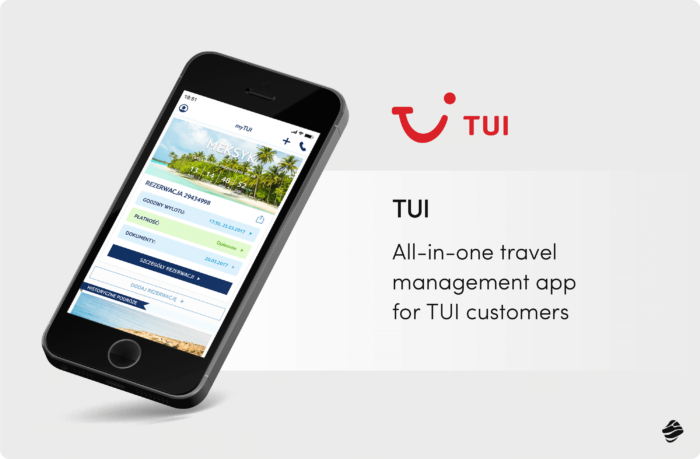
TUI Group is a multinational travel and tourism company headquartered in Germany. With operations in over 180 countries, TUI is one of the largest travel companies in the world, offering a wide range of services such as package holidays, cruises, and hotel reservations.
To enhance its services, TUI opted for nearshore outsourcing, forging a partnership with Miquido. Together, they created a state-of-the-art mobile application to simplify the travel booking experience.
Miquido approach
- Miquido began by analyzing TUI’s needs to tailor the app accordingly.
- Throughout development, Miquido and TUI collaborated closely, adjusting based on feedback.
- Miquido employed advanced technology to develop a user-friendly and visually appealing app.
- Robust security measures were implemented by Miquido to safeguard user data.
- Miquido also provided extensive training and support to TUI’s team for a seamless launch.
Results
- The mobile app solution developed by Miquido helped TUI streamline its travel management processes and improve overall efficiency.
- TUI saw increased customer engagement and satisfaction due to the app’s user-friendly design.
- The app’s robust security features protected customer data, increasing trust and loyalty among users.
- TUI experienced a significant boost in revenue and business growth due to Miquido’s mobile app solution.
Transform Your Business with Nearshore Outsourcing
Nearshore outsourcing presents a strategic approach for businesses to tackle talent shortages by accessing skilled professionals in neighboring countries. This model ensures smoother communication, cultural compatibility, and operational efficiency due to shared time zones and regulatory frameworks.
While legal complexities and cultural differences can pose challenges, nearshore outsourcing offers scalable solutions, high-quality outcomes, and effective collaboration. With digital transformation and strategic partnerships gaining importance, nearshoring is well-positioned to continue expanding.
Differences Between Staff Augmentation and Project Outsourcing
Understanding the differences between staff augmentation and project outsourcing is crucial for businesses to make informed decisions. Staff augmentation involves integrating external professionals into your existing team, allowing for direct control over the work process and leveraging specialized skills for specific tasks. In contrast, project outsourcing entails handing over an entire project to an external team or firm, which manages and delivers the project from start to finish. This approach can be beneficial for businesses looking to focus on core operations while leveraging external expertise for complete project execution.
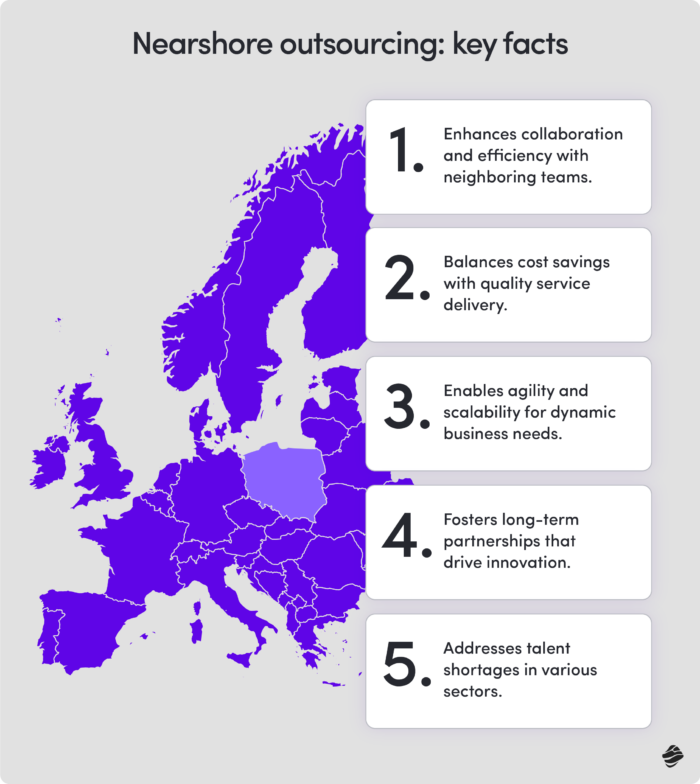
Key takeaways:
- Nearshore sourcing enhances collaboration and efficiency with neighboring teams.
- It balances cost savings with quality service delivery.
- Enables agility and scalability for dynamic business needs with nearshore outsourcing.
- Fosters long-term partnerships that drive innovation through nearshore outsourcing.
- Addresses talent shortages in various sectors through nearshore talent pools.
As nearshore outsourcing continues to reshape global business strategies, the significance of partnering with a reliable and forward-thinking software development firm becomes paramount. This is where Miquido steps in. With its industry-specific IT solutions and services, Miquido empowers your business to thrive in a competitive market.Elevate your business with Miquido’s state-of-the-art technology solutions, including team augmentation, custom app development, AI software, and mobile app expertise, all backed by our highly skilled professionals.









